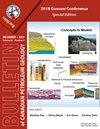The role of differential chemical compaction in the formation of the Gold Creek Collapse Structure, West Central Alberta
Q3 Earth and Planetary Sciences
引用次数: 1
Abstract
Abstract The Gold Creek Gas Field has produced in excess of 2.5 billion cubic meters (>90 Bcf) of gas plus natural gas liquids from the Upper Devonian Wabamun Formation. The Wabamun is a 220 m thick limestone that is only porous and productive where fault-controlled dolomite is present. These faults are associated with a significant episode of structural collapse that has resulted in up to 160 m of negative relief on the Wabamun structure. Compensatory thickening of the overlying Mississippian Formations accompanied subsidence. The mechanism of collapse is interpreted to be differential compaction within the underlying Devonian Leduc reef. In response to overburden pressure, the muddy lagoonal sediments of the Leduc reef interior are interpreted to have undergone a higher degree of stylolitization than the coarser grained reef margin. Differential compaction commenced at the onset of Mississippian deposition and reached its zenith during Debolt Formation deposition. During the early stages of this process, the Leduc reef had been a closed diagenetic system that limited the magnitude of differential compaction. Debolt age rapid subsidence induced faulting that extended upwards from the Leduc through to the Debolt Formation. It is interpreted that CaCO3 saturated fluids were expelled from the Leduc reef and flowed upwards along the faults through the overlying Mississippian sediments and presumably to the surface. This permitted chemical compaction to proceed within the reef at a greatly accelerated rate leading to reef collapse. A second, more modest period of collapse occurred slightly later during Stoddart Group deposition. Seismic data along with isopach and structural mapping were used to quantify the amount of compensatory thickening that occurred and to establish the chronology of associated faulting. The Gold Creek Collapse Structure formed in three stages during the Mississippian Period. The first stage occurred during deposition of the Exshaw to Shunda Formation interval. The second stage occurred during Debolt Formation deposition and the remaining subsidence occurred during Stoddart Group deposition. Depth of burial of the Gold Creek Leduc Reef increased from 335 m to 743 m during stage one. During stages two and three the depth of burial increased to 992 m and 1035 m, respectively.不同化学压实作用在阿尔伯塔中西部金溪崩塌构造形成中的作用
Gold Creek气田从上泥盆统Wabamun组开采了超过25亿立方米的天然气和液化天然气。Wabamun是一种220米厚的石灰岩,只有在断层控制白云岩存在的地方才具有多孔性和生产力。这些断层与一次重大的构造崩塌事件有关,导致了瓦巴蒙构造上高达160米的负起伏。上覆密西西比地层的补偿性增厚伴随沉降。崩塌的机制被解释为下伏泥盆系勒杜礁内部的差异压实作用。在覆盖层压力的作用下,勒杜克礁内部的泥质泻湖沉积物比粗粒度的礁缘经历了更高程度的柱石化。差异压实作用始于密西西比期沉积初期,在德博特组沉积时期达到顶峰。在这一过程的早期阶段,勒杜克礁是一个封闭的成岩系统,限制了差异压实的程度。德博尔特时代的快速沉降诱发了从勒杜克向上延伸至德博尔特组的断裂。据解释,CaCO3饱和流体从Leduc礁中喷出,沿着断层向上流动,穿过上覆的密西西比期沉积物,可能到达地表。这使得化学压实在珊瑚礁内以极大的加速速度进行,导致珊瑚礁崩溃。第二次较为温和的崩塌发生在稍晚的斯托达特群沉积期间。利用地震数据、等厚层和构造图来量化发生的补偿性增厚的数量,并确定相关断层的年表。金溪崩塌构造在密西西比时期分三个阶段形成。第一阶段发生在Exshaw -顺达组段沉积时期。第二阶段沉降发生在Debolt组沉积时期,剩余沉降发生在Stoddart组沉积时期。在第一阶段,金溪勒杜克礁的埋藏深度从335米增加到743米。在第二阶段和第三阶段,埋深分别增加到992米和1035米。
本文章由计算机程序翻译,如有差异,请以英文原文为准。
求助全文
约1分钟内获得全文
求助全文
来源期刊

Bullentin of Canadian Petroleum Geology
Earth and Planetary Sciences-Geochemistry and Petrology
CiteScore
2.50
自引率
0.00%
发文量
0
期刊介绍:
The Bulletin of Canadian Petroleum Geology is a peer-reviewed scientific journal published four times a year. Founded in 1953, the BCPG aims to be the journal of record for papers dealing with all aspects of petroleum geology, broadly conceived, with a particularly (though not exclusively) Canadian focus. International submissions are encouraged, especially where a connection can be made to Canadian examples.
 求助内容:
求助内容: 应助结果提醒方式:
应助结果提醒方式:


